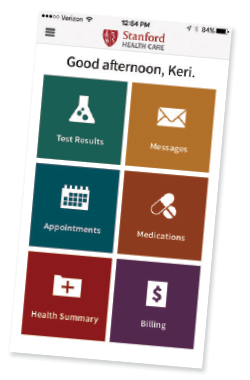“It tends to help with medicine reconciliation,” says Dr. Odutola. “They can look at the list on the portal and easily let me know that they are not taking a medication any more or that another doctor has added one to the regimen.”
She noted that she gets two or three communications a day from patients. Some talk about things that could have waited until the next appointment. Others bring up things that should be addressed quicker or need to be talked about in person before the next scheduled visit.
“On a busy day this extra work can be stressful,” she says. “But patients love the quicker access.”

The patient portal above, MyHealth, is offered by Stanford Health Care. Patients can easily review orders, update medications ordered by non-network physicians, review test results and more.
Third Party or Part of Your EMR
For most, a patient portal comes along with your EMR system. Some practices may find that what they have does not fit in with their needs. It is obvious that comfort with the medical records piece often is a higher priority in these decisions.

Mr. Sharp
“There are pros and cons to having your own portal,” says Mr. Sharp. “If you have your own portal, you can choose the features you want, and it makes it easier to brand it to your practice.”
This is balanced against the need for patient and practice ease of use. For those who share their EMR with an area hospital, it is often easier, and less expensive, to use its portal. You get the hospital’s IT resources to answer questions and deal with problems, and you don’t have to pay for expensive data integration programs if there are interoperability problems. The practice may also have higher use of the portal because the patient doesn’t need to remember yet another password and user name combination.
“Product choices are varied,” says Mr. Sharp. “Many EMR vendors have their own portals available as an add-on feature. However, the practice still needs to make sure that the registration process is easy, it is secure, and the interface is easy to use. This means fewer phone calls about problems and increases the likelihood that patients will use it more than once.”
Third-party portals are available that can connect to the practice’s EMR and draw out basic data. Some smaller companies may be more service oriented for small practices.
Privacy Issues
There is no requirement that a practice request permission from a patient to put their information on a patient portal under the Health Insurance Portability and Accountability Act of 1996 (HIPAA). The Act lets patients access their own data without needing extra paperwork.